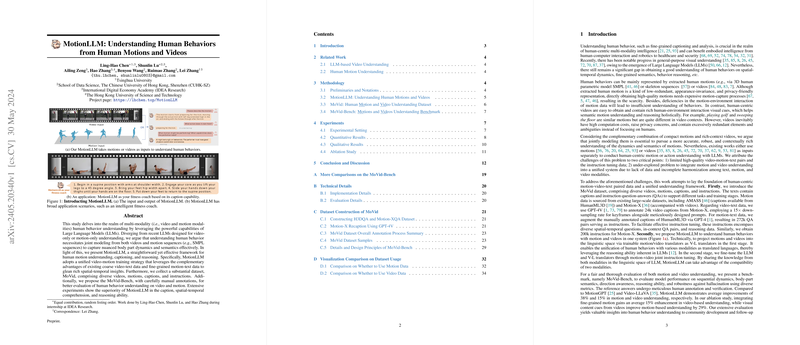MotionLLM: Understanding Human Behaviors from Human Motions and Videos
Overview
The paper "MotionLLM: Understanding Human Behaviors from Human Motions and Videos" proposes a novel approach for the comprehensive understanding of human behaviors through a multi-modality framework named MotionLLM. The framework leverages the complementary strengths of video and motion data alongside LLMs to perform intricate tasks such as motion captioning, spatial-temporal reasoning, and detailed behavior analysis. MotionLLM addresses the gaps existing in current methodologies that predominantly focus on either video-only or motion-only inputs.
Methodology
The authors introduce a two-stage training process to unify motion and video modalities into a coherent system. Firstly, a modality translation stage bridges the gap between vision and linguistic spaces using trainable translators. Specifically, a linear projection for motions and a more complex multi-layer perceptron (MLP) for videos are utilized for this translation. Subsequently, the second stage involves instruction tuning that fine-tunes both the LLM and the translators to enhance the comprehension capabilities for both modalities through joint training.
The introduction of a novel dataset, MoVid, which comprises diverse video, motion, and textual annotations, serves as a cornerstone for effective training. This dataset includes HumanML3D captions augmented into QA pairs (H3DQA), captions for Motion-X, and further question-answer pairs for MotionX-QA produced via GPT-4. The diverse nature of this dataset allows for extensive instruction tuning, thereby boosting the model’s understanding and reasoning capabilities.
Additionally, the paper presents MoVid-Bench, a benchmark specifically designed for evaluating human behavior understanding. MoVid-Bench assesses models on key aspects such as body-part motion awareness, sequence analysis, direction awareness, reasoning skills, and robustness against hallucination through manually annotated datasets.
Results
MotionLLM demonstrates significant performance improvements over existing models. On MoVid-Bench (motion part), MotionLLM outperforms baselines like MotionGPT, achieving an increase of 38% in average accuracy and 12% in average score. These gains are particularly notable in body-part awareness and reasoning abilities.
For video comprehension, MotionLLM exhibits a 15% accuracy improvement over Video-LLaVA on MoVid-Bench (video part). The model shows superiority in handling sequential dynamics and overall reasoning about the video content.
Furthermore, evaluations on specific tasks such as BABEL-QA and ActivityNet-QA substantiate the model’s robustness. MotionLLM demonstrates comparable if not better performance than specialized models on BABEL-QA and achieves a 9% accuracy increase over previous leading models on ActivityNet-QA.
Implications and Future Work
The implications of MotionLLM are profound in both theoretical and practical realms. The approach provides a unified framework that leverages both motion and video inputs, highlighting the potential of multi-modality integration in advancing human behavior understanding. The extensive dataset and benchmark introduced can serve as a standard for future research, enabling fair comparisons and fostering advancements in this area.
In terms of practical applications, MotionLLM has potential use cases in AI-driven fields such as automated fitness coaching for the visually impaired, human-computer interaction, robotics, and beyond. The robustness against hallucination also makes it a reliable tool for real-world applications, enhancing the trustworthiness of the system.
For future developments, addressing the limitations imposed by the current video encoder capacity is crucial. This could involve adopting more advanced video compression techniques to retain the sequential context better. Furthermore, expanding the dataset to cover more diverse human activities and longer sequences can potentially enhance the model’s generalizability and effectiveness in real-world scenarios.
Conclusion
The novel framework proposed in the paper marks a significant stride in understanding and interpreting human behaviors through the integration of multi-modality data and LLMs. By effectively bridging the gap between motion and video data and employing comprehensive instruction tuning, MotionLLM sets a new standard for human behavior comprehension. The promising results and extensive evaluations underscore the robustness and applicability of this approach, paving the way for future innovations in AI-driven human behavior analysis.
